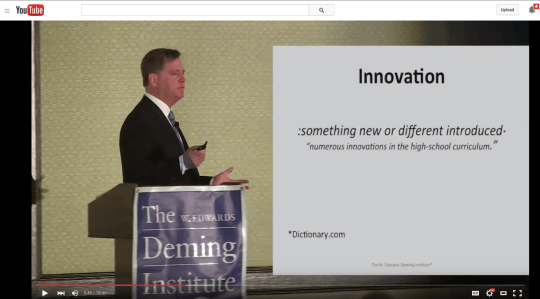 I hope to, some day, attend one of the annual Deming Institute conferences. My friend Mike Stoecklein attends pretty often and has blogged about it.
I hope to, some day, attend one of the annual Deming Institute conferences. My friend Mike Stoecklein attends pretty often and has blogged about it.
You can hear my podcast with Mike here.
The institute posted a video of Kevin Cahill, a grandson of Dr. W. Edwards Deming, welcoming people to the event and talking about innovation, or the desire that people have for it.
See the video with a story starting at 5:45 (embedding has been disabled, it says).
Cahill describes a company that put a box at the front reception desk. The company told their 150 employees that they each HAD to submit two innovative ideas each month. Their performance appraisal at the end of the year would depend on this. There's an additional bonus if one of your ideas is picked.
Listen to my podcast, if you like, with Prof. Samuel Culbert about getting rid of the annual performance review (it's probably one of the most entertaining I've ever hosted).
At this point in Cahill's story, the audience is chuckling a bit as, being Deming students and thinkers, they see intuitively where this is going.
Three months into it, they had 900 suggestions for how to be innovative.
I'll do the math… that's 150 people x 2 ideas / person x 3 months = 900 ideas.
It sounds like people hit their quota (they'll do that under pressure). But what happened when they had 1200 ideas after four months?
“They did NOT know what to do.”
Corporate heard about this “experiment” and said (I think to leadership) that THEIR performance appraisal would depend on how that worked out.
What happened with these quotas and goals?
“Management's interest became about saving themselves.”
I'd add that the focus wasn't on innovation or doing new things that could help customers or the employees or the company. Quotas and targets (with threats or punishment) become a game that people play. We're not at work to play games.
“They were scared to death… it had the reverse effect… driving out innovation and creating more fear in the organization… it became a very hostile work environment,” said Cahill.
I'm not really an expert in “innovation,” but it seems that fear and hostility are NOT the mood or environment that leads to creativity.
Cahill quotes his grandfather, W. Edwards Deming:
“The people that work in any organization know what they are doing, but they will not, by themselves, learn a better way. Their best efforts and hard work only dig deeper the pit that they are working in… do not provide an outside view or lens on the organization.”
So this makes me think about Kaizen and continuous improvement, in healthcare or in other settings.
When I'm teaching about Kaizen, a very common question is about goals, incentives, targets, and rewards. It's almost assumed that people will only participate in Kaizen if you make them do so, somehow.
Dr. Deming would have said “hogwash!,” I believe.
People, especially in healthcare, have incredibly strong intrinsic motivation. They WANT to be heard. They WANT to make things better for themselves and their customers.
Kaizen doesn't require setting goals and targets. Dr. Deming would have said, “Substitute leadership.” There are specific management practices, behaviors, and mindsets that can encourage or squash improvement and innovation. Dr. Greg Jacobson and I have done some webinars on that topic:
- Leadership Behaviors that Create a Culture of Continuous Improvement
- MORE Leadership Behaviors That Create A Culture of Continuous Improvement
- Congratulations, You Have Lots of Employee Ideas! Now What?
- See more webinars, including related thoughts from Jamie Flinchbaugh and Joe Swartz
Last week, at the Northeast Lean conference, I was thinking about continuous improvement and system improvement.
When is the right time to tweak or continuously improve a system? When is the right time to redesign or transform a system?
You can do both through Lean. I teach a lot about continuous improvement and, I guess, the assumption is that there is already a pretty good system in place. That's not always true in healthcare.
I've led a bunch of projects where we were re-designing a department or value stream, “blowing it up” and re-creating the physical layout or process in a way that was a step function improvement, not just a tweak of that existing broken process.
We have to know when to do each – tweak or transform. That requires judgment. Sometimes, you'll be wrong. So you adjust and continue.
Yes, the employees are the experts in doing the work. You need, however, an outside perspective or “fresh eyes.” I often play that role as an outside consultant, or you can bring in people from another department to play that role.
I've brought up a lot of topics here… what do you think?
You can view more 2015 Deming Conference videos in their playlist. The 2016 conference will be in my home state of Michigan (at Michigan State University), so that makes it easier for me to attend.
What do you think? Please scroll down (or click) to post a comment. Or please share the post with your thoughts on LinkedIn – and follow me or connect with me there.
Did you like this post? Make sure you don't miss a post or podcast — Subscribe to get notified about posts via email daily or weekly.
Check out my latest book, The Mistakes That Make Us: Cultivating a Culture of Learning and Innovation:











Too often attributes of leadership behaviors that create the culture of innovation is understated at workplace despite companies. I guess the myth that “what cannot be measured, cannot be managed” is the prevailing system of management that stifles creativity at workplace. Good blog Mark!
Mark- thanks for this post. I just started doing some work with an academic medical center, and their focus seems to be almost entirely on metrics and targets with hardly any attention to teaching PDSA or problem solving skills to staff. Unfortunately, this snowballs as providers and managers divert enormous energy towards discussing how the measurement system isn’t accurate, the data aren’t valid, the comparison AMCs aren’t equivalent, ad nauseum, rather than focusing their efforts on actual improvement or learning activity.
Yeah, focusing on goals or measures without a way to improve seems to create more frustration than anything. Dr. Deming would have asked, “By what method?” By what methods are they actually going to improve?
Google search on the phrase.
I assume that if staff have a hard time with problem solving that senior leadership does also.
I think anyone would hard-pressed to find a senior leadership team with good problem solving skills that don’t have staff with good problem solving skills.